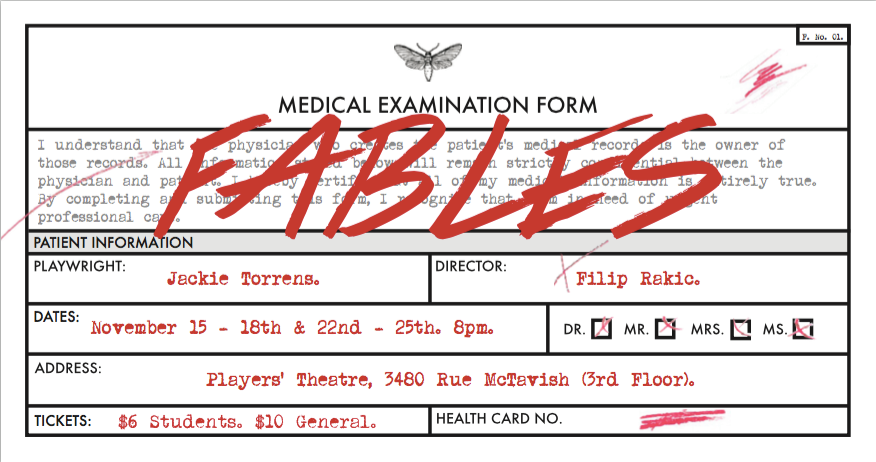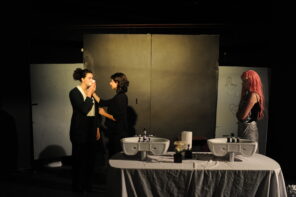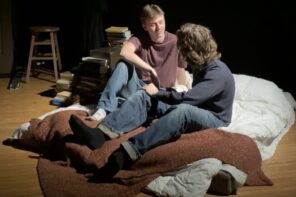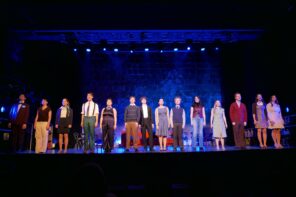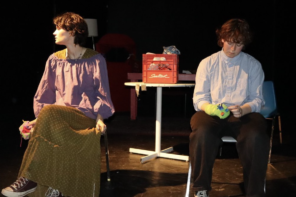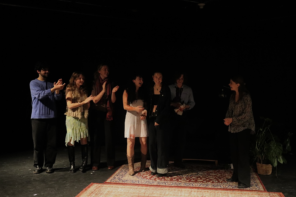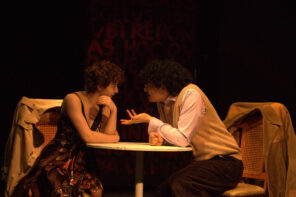Fables is Players’ Theatre’s second production of the year, written by Jackie Torrens, and directed by Filip Rakic.
To those who associate the word ‘fables’ with wholesome stories that end up gift-wrapped, bow-tied, and given to a child who needs to learn how to share, Players’ Theatre’s production of Fables will perhaps be hard to understand. There are no talking animals in races, no talking animals collecting too much or too little grain – to be frank, there are no talking animals at all.
Instead there are four characters, none of whom leave the stage throughout the entire production, and all of whom embody a profound longing for a life somehow beyond their grasp. These four characters, Doctor (played by Thomas Fix), Wife (Sarah Tiplady), Lisa (Emily Sheeran), and Sid (Alexander Sitaras-Grasic), trade monologues, and occasionally dialogue, while territorializing each part of the stage.
The stage is set-up into four distinct areas. On stage right is the Doctor’s office. He sees Sid, a neurotic yet arrogant hypochondriac perpetually chastising the Doctor for his lateness. Sid soliloquizes from a chair he carries to the centre of the stage, a reflection of his own high self regard.
Upstage, there is a lifted platform that serves as the Wife’s living room in which she sits back, makes drinks, and throws sardonic barbs at those with whom she interacts. Her living room is an ingenious aspect of the set design. She is lifted, leaving her continuously visible while other characters are free to roam in front. But it also substantiates her own condescension, perpetually looking down on the other members of the cast, as well as the audience.
Each actor embodies the particular anxiety their characters possess with admirable skill and dexterity
Finally, on stage left is Lisa’s quadrant. She sits on a bench in front of a brick wall, with fake grass put down beneath it. I saw members of the audience trip on it as they entered the theatre, and look up, intrigued at what part it would play. That she is left outside, exposed to the elements, speaks to her inability to combat the myriad problems she faces throughout the play.
Each actor embodies the particular anxiety their characters possess with admirable skill and dexterity. The Doctor, a singularly masculine and traditional figure, must grapple with his own identity as a man. In doing so, Thomas Fix is able to convey a subtlety to the character that could have been lost to an actor merely playing a foil to the more energetic performances of the rest of the cast.
The Wife, a character who could easily have fallen into an archetypal jaded, alcoholic housewife, instead is played by Sarah Tiplady with a sensitivity that is so often missing from this kind of role. The humour she injects into the role, especially when crying in a movie theatre and watching The Invisible Man, humanizes her.
The gift of Sheeran’s performance is the combination of innocence with a cynicism borne of continued disappointment and trauma
Lisa is the role that requires the most sensitivity and dexterity. The experience that Emily Sheeran has to perform is difficult to watch and all the more powerful because of it. She is able to absorb the attention of the entire audience, while sharing the stage with three other actors. The gift of Sheeran’s performance is the combination of innocence with a cynicism borne of continued disappointment and trauma.
Lastly, there is Grasic’s incredible performance as Sid. With a mesmeric, jolting cadence, he strings the audience along with his exhausting mental processes. I could feel the audience lean forward in anticipation when he would sit his chair in the centre of the stage, ready to once more attempt to explain away his own neuroses, or complain about whomever he had interacted with that day.
The mastery of the performances would be left feeling sluggish without Rakic’s direction, which is able to inject energy and dynamism into the performance. Four actors each in their own area, performing monologues and occasionally interacting could have been tiresome, but the permanence of each actor’s performance negated this. Each one was always pacing, or laughing, shooting another a look or taking a drink. The lighting design additionally infuses the production with movement, gliding across the stage, drawing the audience along with it.
In the end, though, what will stick with the audience is the haunting, and at times uplifting, performance of the cast. Their individuality both in characterization and placement on stage is superseded by a collectivity of purpose, which explains their perpetual presence on stage. Each one is inherently important to the other’s performance, colouring their moods and emotions with reaction or non-reaction. For the Doctor to continue working at his desk while his Wife laments her neighbour’s children is as powerful as any other reaction. It goes to show that while we each may get stuck in our own inner-monologues, we cannot forget the constancy of everyone else’s. While we grapple with our own issues and dilemmas, we must remember that those around us are doing the same.
You can see Fables November 15-18 and 22-25 at 8pm in Players’ Theatre. Tickets are $10 general and $6 for students.

